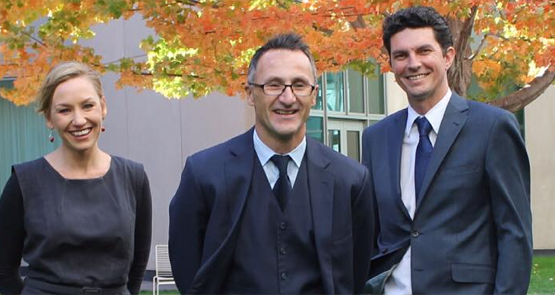
The 2013 election resulted in a record vote for minor parties — over 21%. In this election year, even more Aussie voters will weigh up not just which major party to choose, but whether to vote for a minor party.
There is a good case for many people doing so.
Major parties are unlikely to implement their whole platforms. There’s always a reason to drop some tricky policy. Unless, that is, they are under pressure from a minor party on their extreme side.
For Labor, that minor party is the Greens. For the Coalition, that minor party might be the Liberal Democrats, the Palmer United Party, the Nationals or others.
When the minor party is strong, the risk of losing votes to it forces the major party to cater to those who might go to the minor party, not just those who might swap to the other side of the aisle.
Strategic voters whose politics align with Labor may therefore vote for the Greens. Even though they prefer their politics more mild, they know the inertia of the political system dilutes all policies that are introduced. Without the Greens lurking, Labor will tend to slide toward the Coalition. That same inertia means the Greens platform — with which voters are unlikely to fully agree — will not be implemented in whole.
The effect of minor parties on major parties has been studied extensively in the political science. Those who obsess over seats in parliament as the sole measure of power will fail to recognise the effect of minor parties in shifting the political centre, and therefore in shifting what is politically possible.
The short federal political career of One Nation founder Pauline Hanson may have paved the way for John Howard’s tough refugee policies, for example, and the rise of the Greens has been instrumental in Labor consistently having a price on carbon in their policy platform, despite its wretched effects on the party’s public image.
Minor party MPs may also win more in parliament.
The value of taking an extreme position is something moderate politicians must learn on the job. US President Barack Obama acquired this lesson the hard way after taking a centrist position on the expiration of the former president George Bush’s tax cuts. Think Progress quotes him on this topic:
“I suppose what I could have done is started off with no tax cuts, knowing that I was going to want some and then let them take credit for all of them. And maybe that’s the lesson I learned.”
The credibility of the bargaining position of a moderate politician is never as strong as that of a more extreme one.
Getting a party to deliver depends on the threat voters will abandon that party in the next election, and on having the right people in the houses of parliament to make it happen.
For people who want to be sure Labor will deliver on the emissions trading scheme it has promised, it may be wise to preference the Greens. The risk an emboldened Greens Party again permits the perfect to be the enemy of the good and derails the ETS is not zero — but almost certainly less than the risk Labor derails or delays the plan itself.
Similarly, people who’d like to get tax cuts delivered may be better off voting for the Liberal Democrats than the Coalition.
But what if voting for more extreme parties causes polarisation?
Voting strategically can be rational for those who want to change Australia quickly. But this could be one of those game theory situations where a collection of individuals acting rationally makes the whole worse.
The rise of strategic voting could lead to increased polarisation, as seen in the United States.
The famous graphic of voting choice in the US Senate shows how polarisation can grow. In America, polarisation can undermine compromise, silence moderate voices, and lead to frequent government shutdowns.
The sorts of stand-offs seen in Australia over wind power and renewable energy could become more common, with consensus missing as the party that has the numbers holds the rest hostage.
For now, the major parties are betting that most voters fear this outcome and prefer a more moderate approach.
In choosing to replace Tony Abbott with Malcolm Turnbull the Liberal Party rejected polarisation and made a step toward moderation. By choosing Bill Shorten over Anthony Albanese, the ALP did the same.
If the 2016 election brings another bumper crop of minor parties heading to Canberra, that strategy might — for better or worse — have had its last chance.








It is a struggle to think of any Greens policy that could be called “extreme”. They have simply remained in the centre-left space while Labor veered wildly rightwards fruitlessly chasing Liberal voters.
On the other hand, it’s pretty trivial to find some fairly extreme policies from the Liberals and they form most of the LDP’s philosophy.
While agreeing with drsmithy, this was a surprisingly rational, and real world, analysis for an economist!
I wouldn’t be touting the credentials shown in the email Jason. It’s so much more credible if people don’t know you’re an economist who wrote for the AFR.
Just saying. 🙂
What a weird post, drsmithy.
How does the Greens Party backing the Coalition on legislation several times last year mean they “simply remained in the centre-left space”???? There is NOTHING centre-left about Talcum Malcum’s LNP…people just think there is going to be. Fools!
The Greens…do as we say, NOT as we do…bunch of hypocrites!!
How does the Greens Party backing the Coalition on legislation several times last year mean they “simply remained in the centre-left space”????
Which legislation in particular are you talking about ?
Typically the Greens vote with the Liberals when the Liberals put forward with something which is already lines up with Greens policy, rare but it does happen occasionally and much less often I would think than Labor and Liberal voting together which is far more than several times a year.